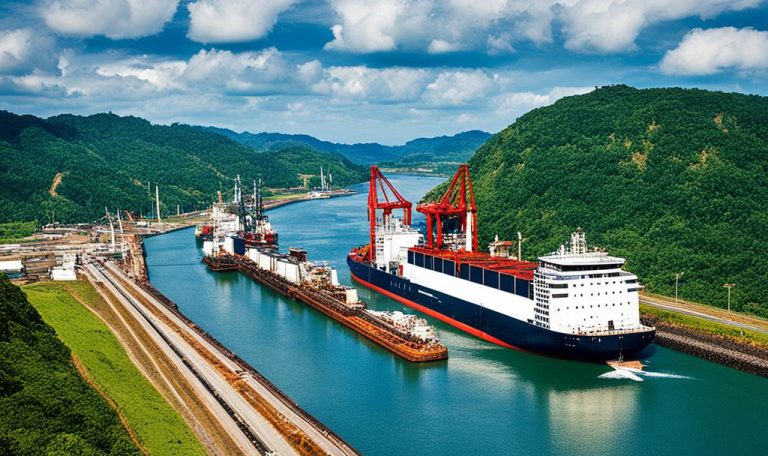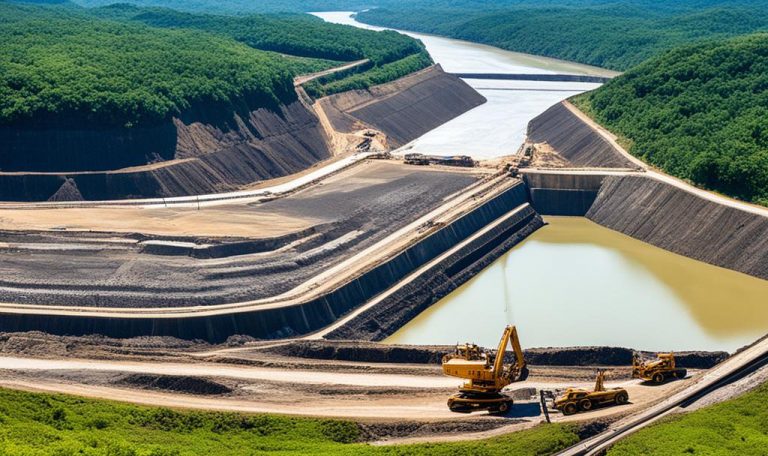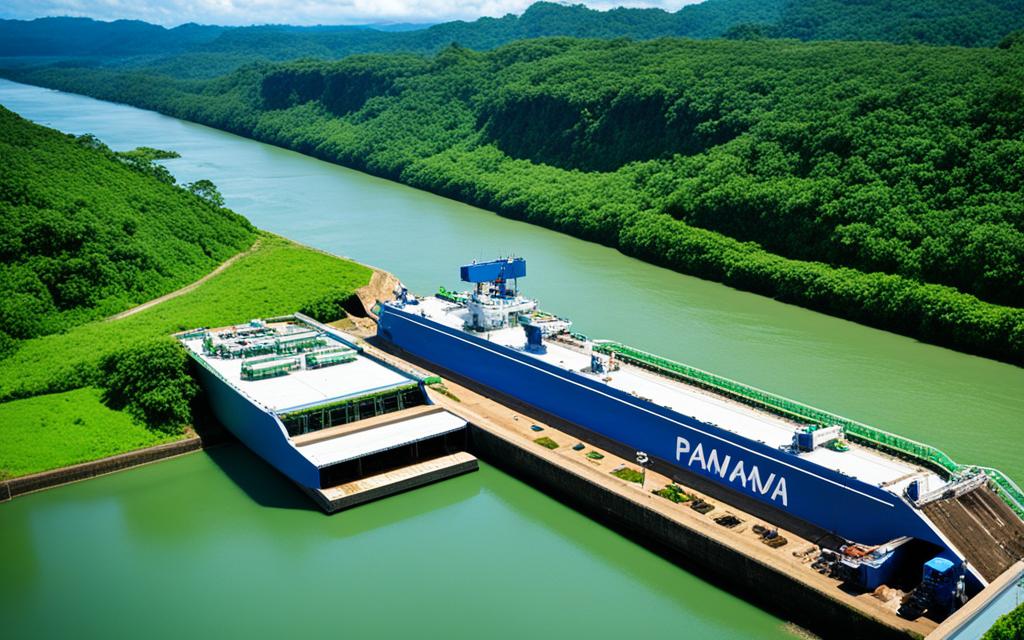As the Panama Canal grapples with a severe water crisis caused by drought conditions, a groundbreaking solution has been proposed to alleviate the strain. This solution aims to bypass the canal altogether, providing a sustainable alternative for international cargo transportation. With climate change and El Niño exacerbating the water shortage, it is imperative to explore innovative measures that ensure the canal’s long-term functionality.
The Multimodal Dry Canal project offers a forward-thinking approach to address the Panama Canal’s water crisis. This ambitious initiative will transport international cargo across a specially designed customs jurisdiction near the waterway, effectively circumventing the drought-stricken canal. By reducing the reliance on freshwater from nearby lakes, the project provides a viable solution to the acute water shortage and helps mitigate the ecological impact of the crisis.
Key Takeaways:
- A new solution has been proposed to address the water crisis in the Panama Canal.
- The Multimodal Dry Canal project aims to transport international cargo across a specially designed customs jurisdiction.
- By bypassing the drought-stricken canal, the project offers a sustainable alternative to alleviate the water shortage.
- Reducing the reliance on freshwater from nearby lakes helps mitigate the ecological impact of the crisis.
- Climate change and El Niño have exacerbated the water shortage, necessitating innovative measures.
The Impact of Drought on the Panama Canal
The operation of the Panama Canal relies heavily on the availability of freshwater from Lake Gatún and Lake Alajuela. Due to the ongoing drought and El Niño phenomenon, the water levels in these lakes have significantly decreased, presenting challenges for vessels passing through the canal’s locks.
Water management for the Panama Canal is crucial to ensure the successful navigation of ships. The locks require a substantial amount of freshwater to function properly. The depletion of water levels has led to difficulties in maintaining the desired depth for vessels, potentially hindering their passage through the locks.
The effects of this water shortage extend beyond ship navigation. Panama Canal environmental strategy needs to consider the broader impact on the local marine ecosystem and the availability of drinking water supplies in the surrounding areas. The reduced water levels increase the salinity of the canal, which can adversely affect marine life and interrupt the delicate balance of the ecosystem.
To address these challenges and ensure the long-term sustainability of the Panama Canal, it is essential to implement an effective water management plan. This plan should focus on optimizing water usage, exploring alternative sources of freshwater, and investing in infrastructure improvements to adapt to changing environmental conditions.
The Drought’s Impact on Shipping
The impact of the drought on the Panama Canal extends beyond environmental concerns. Ships passing through the canal face operational challenges due to reduced water levels, leading to restrictions on the number of ships that can traverse the locks.
This reduction in the number of ships passing through the canal system inevitably results in delays, congestion, and potential losses for shipping companies. The slowdown in trade flow can disrupt supply chains and affect the global economy.
Quote
“Water shortages and the associated operational challenges have underscored the urgent need for a sustainable solution for Panama Canal drought. Balancing the demands of global shipping while preserving the delicate ecosystem requires a comprehensive approach to water management and environmental stewardship.” – Maria Rodriguez, Environmental Analyst
Striking a balance between commerce and the preservation of natural resources in the face of climate change is paramount. The Panama Canal Authority must actively pursue innovative water management strategies to navigate the challenges caused by drought conditions. By taking proactive steps, such as implementing advanced monitoring systems and exploring water-saving technologies, the Panama Canal can mitigate the impacts of drought and ensure the uninterrupted flow of international trade.
To fully understand the magnitude of the drought’s impact on the Panama Canal, let’s examine the key factors affected by water scarcity:
| Factors Affected by Water Scarcity | Implications |
|---|---|
| Ship Navigation | Delays, congestion, and potential losses for shipping companies. Disruption to global supply chains. |
| Local Marine Ecosystem | Increased salinity levels, negative impact on marine life, and potential long-term ecological damage. |
| Drinking Water Supplies | Reduced availability of drinking water for local communities and the surrounding areas. |
As global climate patterns continue to evolve, proactive measures must be taken to address water scarcity in the Panama Canal. The development and implementation of a comprehensive panama canal environmental strategy focused on sustainable water management will help safeguard the canal’s future and mitigate the adverse effects of drought on the ecosystem and shipping operations.
The Need for the Multimodal Dry Canal Project
The Panama Canal is facing a severe water shortage crisis that calls for a comprehensive solution. In response, the proposed Multimodal Dry Canal project offers a much-needed alternative to address the pressing issue of water scarcity. The current locks of the Panama Canal are ill-equipped to meet the growing demand for freshwater, and with climate change projections indicating persistent drought conditions, a strategic plan is essential.
The Multimodal Dry Canal project aims to provide an alternate route for international cargo transportation, leveraging existing infrastructure such as roads, railways, port facilities, airports, and duty-free zones. By diverting a portion of the cargo away from the canal, this innovative project promises to alleviate congestion and reduce the strain on the canal’s water resources. Furthermore, it presents an excellent opportunity for infrastructure development and expansion, catering to the escalating trade needs of the region.
The expansion and development of the canal’s infrastructure will not only bolster its capacity to handle trade growth but also contribute to the economic progress of Panama. With the implementation of the Multimodal Dry Canal project, the region can harness the existing transportation networks effectively, minimizing the need for costly construction and investment.
Through the integration of roads, railways, ports, airports, and duty-free zones, the Multimodal Dry Canal project optimizes trade routes, ensuring economic sustainability and growth for both Panama and its valued trading partners. By reducing reliance on the canal, this innovative solution paves the way for a more diversified and resilient trade network.
By investing in the Multimodal Dry Canal project and prioritizing infrastructure development, Panama sets the foundation for long-term success in navigating the water shortage crisis. The project aligns with the country’s commitment to adapt and overcome the challenges posed by climate change and ensures the continued economic viability of the Panama Canal. Furthermore, this strategic initiative showcases Panama’s vision to foster sustainable trade practices and be a global leader in managing water resources efficiently.
Benefits of the Multimodal Dry Canal Project
Implementing the Multimodal Dry Canal project holds substantial benefits for the sustainability and efficiency of the Panama Canal:
- Alleviates congestion by diverting some cargo away from the canal, reducing traffic and delays.
- Preserves the canal’s water resources by easing the strain on freshwater supplied through the locks.
- Facilitates infrastructure development and expansion, supporting the region’s growing trade needs.
- Boosts economic growth by leveraging existing transportation networks, reducing the need for extensive construction and investments.
- Enhances strategic trade routes, strengthening trade relationships and opportunities for Panama and its global partners.
With these advantages in mind, the Multimodal Dry Canal project offers a viable and sustainable solution to address the water shortage crisis while supporting the long-term growth and prosperity of the Panama Canal and its surrounding region.
| Benefits of the Multimodal Dry Canal Project |
|---|
| Alleviates congestion by diverting cargo away from the canal |
| Preserves water resources |
| Facilitates infrastructure development and expansion |
| Boosts economic growth |
| Enhances strategic trade routes |

Benefits of the Multimodal Dry Canal
The implementation of the Multimodal Dry Canal project brings several benefits to the Panama Canal and the surrounding region.
1. Sustainable Solution: By reducing the reliance on freshwater from the lakes, the Multimodal Dry Canal provides an innovative solution to the water shortage crisis in the Panama Canal. This approach helps conserve water resources and mitigates the impact on the local ecosystem. Shipments can now bypass the canal, reducing the strain on the water supply.panama canal drought solution, innovative solution for panama canal drought
2. Infrastructure Development and Economic Growth: The project opens up new avenues for infrastructure development and supports economic growth. By utilizing existing transportation networks, including roads, railways, port facilities, airports, and duty-free zones, the Multimodal Dry Canal maximizes efficiency. This approach eliminates the need for costly construction and investment, while simultaneously improving logistics and increasing trading capabilities.panama canal infrastructure development
3. Enhanced Strategic Trade Routes: The Multimodal Dry Canal contributes to the enhancement of strategic trade routes, benefiting not only Panama but also major trading partners such as the US, China, Japan, and South Korea. By diversifying the transportation options, this project helps maintain smooth international trade flows and promotes global economic stability.panama canal drought solution
| Benefits | Description |
|---|---|
| Sustainable Solution | Reduces reliance on freshwater and conserves water resources. |
| Infrastructure Development and Economic Growth | Utilizes existing transportation networks, minimizing costs and supporting economic growth. |
| Enhanced Strategic Trade Routes | Promotes smooth trade flows and strengthens relationships with major trading partners. |
A Costly Detour for Shipping Companies
While the Multimodal Dry Canal project offers significant advantages, there are concerns about the potential costs for shipping companies. Land-based detours may incur additional expenses, which can ultimately be passed onto consumers. However, the overall benefits of reducing congestion, ensuring water sustainability, and supporting long-term trade growth outweigh the potential costs. It is crucial for shipping companies to adapt and invest in alternative routes to navigate the changing landscape of the Panama Canal.
Challenges of Land-Based Detours
Implementing land-based detours for shipping companies navigating the Panama Canal introduces additional costs and logistical challenges. Rerouting cargo to existing roads and railways requires coordination and investment in infrastructure upgrades. These costs can potentially impact the affordability of goods for consumers.
Shipping companies need to consider the long-term benefits of the Multimodal Dry Canal project. By embracing new routes and innovative solutions, they can adapt to the changing needs and environmental demands of the Panama Canal, contributing to sustainable growth and efficient trade operations.
Investing in Alternative Routes
While there may be initial costs associated with alternative routes, it presents shipping companies with an opportunity to diversify their transportation strategies and reduce reliance on the traditional canal route. By exploring alternatives such as surrounding ports and intermodal transportation, shipping companies can streamline their operations and reduce the impact of congestion on the Panama Canal.
Adapting to a Changing Environment
The Panama Canal’s water shortage is a clear indication of the need for innovative solutions and alternative shipping routes. Shipping companies must embrace the challenge of navigating the changing landscape and invest in sustainable practices. By prioritizing water conservation and adopting environmentally friendly technologies, companies can contribute to the long-term sustainability of the Panama Canal ecosystem.
| Pros | Cons |
|---|---|
| Reduces congestion on the Panama Canal | Potential additional costs for shipping companies |
| Ensures water sustainability for the canal | Logistical challenges of implementing land-based detours |
| Supports long-term trade growth | Impact on the affordability of goods for consumers |

Environmental Considerations
The Panama Canal’s water crisis has had a significant impact on the environment, and effective measures must be taken to address and mitigate these concerns. The prolonged period of drought and the resulting decrease in water levels have already caused negative effects on the local marine ecosystem and drinking water supplies.
As the Panama Canal continues to play a crucial role in global trade, it is imperative to develop and implement a comprehensive environmental strategy that focuses on effective water management, conservation, and long-term sustainability.
The key component of such a strategy is reducing water usage. By implementing measures to optimize water consumption and minimize waste, the Panama Canal can significantly reduce its ecological footprint and contribute to the preservation of valuable water resources.
In addition to water management, promoting eco-friendly practices is essential to minimize the impact of the canal’s operations on the environment. This can include initiatives such as retrofitting vessels with cleaner technologies, encouraging the use of renewable energy sources, and adopting sustainable waste management practices.
“The Panama Canal has a responsibility to protect the unique biodiversity of the area,” says Dr. Maria Fernández, a leading environmental scientist. “By implementing a comprehensive environmental strategy, we can ensure that the canal’s operations are sustainable and do not harm the fragile ecosystem.”
Preserving the diverse marine life surrounding the Panama Canal is crucial to maintaining a balanced and healthy ecosystem. Protective measures can include creating marine protected areas, establishing habitat restoration programs, and implementing strict regulations to prevent pollution and overfishing.
To visually illustrate the importance of environmental considerations, here is a table outlining the potential impacts of the Panama Canal’s water crisis and the corresponding environmental strategies:
| Potential Impact | Environmental Strategies |
|---|---|
| Depletion of local marine ecosystem | Establish marine protected areas, implement habitat restoration programs, monitor and regulate vessel traffic |
| Reduced availability of drinking water | Implement water conservation measures, invest in water infrastructure, promote responsible water usage |
| Disruption of species migration patterns | Conduct research on migration patterns, develop and maintain wildlife corridors, mitigate construction-related disturbances |
| Increase in pollution levels | Enforce strict pollution control regulations, promote eco-friendly practices among vessels, invest in wastewater treatment facilities |
By incorporating these environmental strategies into the operations of the Panama Canal, steps can be taken towards ensuring long-term sustainability and minimizing the impact on the surrounding ecosystems. Balancing trade and environmental preservation is vital for the continued success and health of the Panama Canal.
Ensuring Long-Term Sustainability
To ensure the long-term sustainability of the Panama Canal, it is imperative to implement innovative solutions that effectively address the water crisis and adapt to the challenges posed by climate change. One such solution that shows great promise is the Multimodal Dry Canal project. This groundbreaking initiative serves as a stepping stone towards a more sustainable future for the canal and its surrounding regions.
The Multimodal Dry Canal project is a significant undertaking that complements other efforts aimed at improving water management, investing in infrastructure, and promoting environmental stewardship. By integrating these measures, we can create a comprehensive and holistic approach to safeguard the long-term viability of this vital global trade route.
Through the implementation of sustainable practices and infrastructure development projects, the Panama Canal can minimize its ecological footprint while continuing to thrive as a crucial thoroughfare for international trade. This means striking a delicate balance between economic growth and environmental preservation.
The Multimodal Dry Canal: A Sustainable Solution
The Multimodal Dry Canal project offers a sustainable solution to the water crisis faced by the Panama Canal. By diverting cargo away from the waterway and utilizing existing transportation networks such as roads, railways, airports, and port facilities, this innovative bypass helps reduce congestion and alleviate the strain on water resources.
“The Multimodal Dry Canal project not only provides relief during the current water crisis but also offers a long-term strategy to maintain the canal’s functionality in the face of future droughts and climate uncertainties.” – María Alejandra Camaño, Environmental Scientist
This strategic initiative serves as a model for sustainable infrastructure development and embraces the principles of environmental stewardship. It showcases the importance of finding practical and forward-thinking solutions to ensure the canal’s long-term sustainability.
The Role of Water Management and Environmental Stewardship
Effective water management is crucial to the long-term sustainability of the Panama Canal. This includes measures to optimize water usage, implement conservation practices, and promote ecosystem preservation within the canal’s vicinity.
Furthermore, the development of a comprehensive environmental strategy is essential to minimize the impact on the local ecosystem and drinking water supplies. By prioritizing environmental protection and sustainability, the Panama Canal can fulfill its economic role while safeguarding the natural resources that support the region’s delicate ecosystem.
Collaboration for a Sustainable Future
Achieving long-term sustainability for the Panama Canal requires collaboration between various stakeholders, including government entities, shipping companies, environmental organizations, and local communities. By fostering partnerships and open dialogue, we can work towards common goals that prioritize both economic growth and environmental responsibility.
By investing in sustainable infrastructure, implementing effective water management strategies, and promoting environmental stewardship, we can ensure that the Panama Canal remains a vital and thriving trade route for generations to come.
Conclusion
The Multimodal Dry Canal project serves as an innovative and sustainable solution to address the impact of drought on the Panama Canal. By leveraging existing infrastructure and diverting cargo to alternative routes, the project not only improves trade efficiency but also reduces congestion, ensuring the long-term sustainability of the canal. In a changing global climate, it is imperative for infrastructure development and environmental strategies to work hand in hand. Through collaborative efforts and forward-thinking approaches, the Panama Canal can evolve and thrive, continuing to connect trade routes and support economic growth.
As the Multimodal Dry Canal project progresses, it presents an opportunity for further infrastructure development and expansion, catering to the region’s growing trade needs. By embracing innovation and investing in the canal’s infrastructure, Panama can adapt to future challenges and position itself as a global leader in sustainable transportation.
In conclusion, the Multimodal Dry Canal project is a forward-looking initiative that not only addresses the immediate impact of the drought but also lays the foundation for the future of the Panama Canal. Through its innovative approach and emphasis on infrastructure development, the project ensures the canal’s ability to facilitate international trade while minimizing its ecological footprint. By combining these efforts with comprehensive environmental strategies, Panama can navigate the evolving landscape and secure the long-term success of the Panama Canal.



